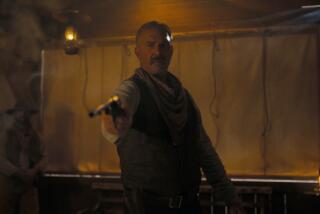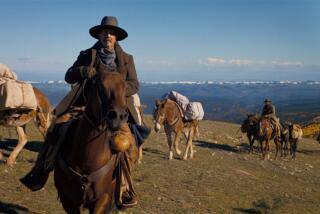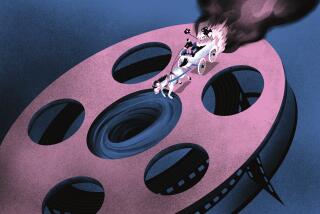Review: James Gray’s hauntingly beautiful ‘The Lost City of Z’ is Charlie Hunnam’s finest performance

Justin Chang reviews ‘The Lost City Of Z’, directed by James Gray, starring Charlie Hunnam, Robert Pattinson, Sienna Miller, Tom Holland, Angus Macfadyen, Ian McDiarmid, Franco Nero. Video by Jason H. Neubert.
- Share via
In May 1925, the legendary British explorer, surveyor and archaeologist Lt. Col. Percy Fawcett vanished, along with his son Jack and their friend Raleigh Rimmell, while searching for the ruins of an ancient South American civilization. It was Fawcett’s eighth expedition to the Amazon, and it’s the third one we see dramatized in “The Lost City of Z,” James Gray’s rich, meditative and deeply transporting portrait of a man who found himself compelled to enter the jungle again and again, even if it meant leaving behind his family and defying the expectations and assumptions of those who sent him.
“A man’s reach should exceed his grasp,” Fawcett notes, and so, perhaps, should the reach of any filmmaker trying to get a handle on this particular mystery. And Gray, a shrewd and soulful Hollywood classicist, has duly allowed Fawcett’s obsession to fuel his own. In hacking his way through the tangled narrative undergrowth of David Grann’s nonfiction bestseller, and transforming the Amazon’s legendary “green hell” into a heavenly celluloid vision, the director evinces the kind of faith in the power of cinema that once led masters like Francis Ford Coppola and Werner Herzog into their own storied episodes of downriver madness.
Among other things, that faith has compelled Gray to leave his native New York, an urban jungle that he has spent most of his career colonizing, starting with his 1994 Brighton Beach-set crime thriller, “Little Odessa,” and culminating in his epic Ellis Island melodrama, “The Immigrant” (2013). If that film’s ambitious period re-creation and elegiac sense of tragedy pointed the way toward “The Lost City of Z,” it’s still remarkable how boldly Gray approaches two new and equally distant early 20th century frontiers here, stretching from the upper echelons of British society to the uncharted reaches of the South American wilderness.
This is easily Hunnam’s finest and most disciplined film performance.
— Justin Chang
Fawcett, for his part, seems to have felt much more at home in the latter. He is played by Charlie Hunnam (“Sons of Anarchy”), who, despite his handsome blond features and athletic build, projects little in the way of a golden boy’s arrogance. When we first meet Fawcett in 1905, he is an undecorated British army major stationed in Cork, Ireland, eager to distinguish himself and erase the damaging legacy of his father’s dissolute ways.
An assignment from the Royal Geographical Society of London — a two-year mapmaking expedition along the much-disputed border of Bolivia and Brazil — does not quite promise the glorious destiny he has in mind. But across the Atlantic, into the jungle and down the Amazon he goes, leaving behind his pregnant wife, Nina (Sienna Miller), and their young son, Jack, and plunging into a world where deadly diseases, sharp-toothed predators and wary tribespeople lie in wait for him and his comrades, Henry Costin (Robert Pattinson) and Arthur Manley (Edward Ashley).
But the jungle’s natural wonders and horrors are not what seem to interest Gray most. Notwithstanding a snake, a panther and a bloodthirsty school of piranhas, the director has largely cut back on Grann’s endlessly detailed panoply of creepy-crawlies without in any way derailing the viewer’s sense of wonderment. Shooting on 35-millimeter film (as he did with “The Immigrant”), the cinematographer Darius Khondji duly honors the intoxicating beauty of this humid emerald forest in luminously textured images that seem to beckon us as surely as they must have beckoned Fawcett.

Charlie Hunnam, Robert Pattinson and Sienna Miller star in “The Lost City of Z.”
Amid the gathering mists, the dense foliage and the immersive soundscape, which occasionally merges with the restrained swells of Christopher Spelman’s score, you might glean the flickering specters of great movies past. A jaw-droppingly surreal interlude in which Fawcett stumbles on an opera house in a clearing nods to “Fitzcarraldo,” while a sudden ambush signaled by a deadly rain of arrows is scarcely Gray’s sole invocation of “Apocalypse Now.”
It is here too that Fawcett uncovers his first clues — hand-sculpted artifacts, whispers among the indigenous people he encounters — that this jungle may hold the remnants of a lost civilization. This fabled El Dorado looms ever larger in Fawcett’s imagination when he returns to London and tries to persuade his fellow society members of a city that may predate Western civilization — an idea that Gray dramatizes, in a terrifically raucous sequence, as an affront to the cultural arrogance of the British Empire.
‘The Lost City of Z’ attacks the era’s colonialist attitudes with a bracingly modern spirit.
The discoveries that fascinate Gray here are not strictly anthropological, and his sense of the world as a teeming jungle, cruel and merciless and indifferent to human survival, does not begin and end with the Amazon. He shows us the essential hypocrisy of a civilization in which human beings can be subjected to rigid yet arbitrary class divisions one minute, then tossed into the great, bloody equalizer of World War I the next — as we see when Fawcett, Costin and Manley find themselves caught up in the 1916 Battle of the Somme, whose horrifying brutality the film evokes with extraordinary vividness and restraint.
In the face of these atrocities, it makes a strange kind of sense that Fawcett might feel more at home in the company of a cannibal tribe he encounters on a 1912 expedition back to the Amazon. “We must attempt to engage,” he tells his fellow explorers, none more quietly loyal than Costin, whom the thickly bearded Pattinson plays with wry, witty understatement. Costin stands in stark contrast to the cowardly and treacherous James Murray (a supremely loathsome Angus Macfadyen), a fellow society traveler who will prove to be a thorn in Fawcett’s side even after they return home.
For all its lush, golden-hued classicism, which might seem to invite the temptations of nostalgia, “The Lost City of Z” attacks the era’s colonialist attitudes with a critical and bracingly modern spirit. Fawcett doesn’t approach the “savages” as a white savior or superior; he shows them the same respect (perhaps more) that he accords his own peers, reserving his contempt instead for the rubber-producing industry that has decimated their region.
If this Fawcett is a model of enlightenment in many ways, he remains very much a man of his moment in others. Some of the picture’s most gripping moments reveal the personal toll of his long absences from home, including one scene in which Nina — played by Miller in one of her sharpest performances — gives angry voice to the realization that her own adventurous and independent spirit has no outlet in this patriarchal world. Fawcett’s complicated relationship with Jack (played as a teenager by Tom Holland) is no less beautifully realized, and their initial estrangement finds moving reconciliation in the vast adventure that awaits and unites them at movie’s end.
Hunnam was cast as Fawcett after Brad Pitt (one of the film’s executive producers) and Benedict Cumberbatch bowed out, and that inevitable sense of having something to prove can only have helped; this is easily his finest and most disciplined film performance. His Fawcett might have benefited from a touch more madness, a more consuming sense of obsession, but you feel it blazing within him nonetheless, inseparable from the keen intelligence and tremendous physical fortitude that made him such an exemplary explorer.
“The Lost City of Z” is the kind of picture whose classicism, a term often confused with conventionality, feels increasingly like a radical statement of intent. Fawcett’s journeys into the Amazon, each one drawing him a little further into his heart of darkness, provide the film with a steady rhythm and a clean three-act structure, but its hauntingly lyrical final scenes deliver the very opposite of closure. The movie may, in the end, frustrate your desire for straight-up thrills and clear answers, but its irresolution is masterful — sincere, generous and entirely appropriate to the deeply searching story it has to tell.
Fawcett has become a near-mythic avatar of obsessive wanderlust; his travels inspired great writers including Sir Arthur Conan Doyle and Evelyn Waugh, and he is purported to be a chief inspiration for Indiana Jones. In the decades following his disappearance, numerous explorer-disciples attempted to retrace his steps, and many paid for the attempt with their own lives. Gray offers up his own poetic speculation, but he doesn’t pretend to know any of the answers they sought. His movie is an incandescent reminder that the world’s most beautiful mysteries endure precisely because they remain unsolved.
------------
‘The Lost City of Z’
MPAA rating: PG-13, for violence, disturbing images, brief strong language and some nudity
Running time: 2 hours, 20 minutes
Playing: Arclight Cinemas, Hollywood, and the Landmark Theatre, West Los Angeles
See the most-read stories in Entertainment this hour »
Movie Trailers
ALSO
Review: A father doesn’t always know best in the gripping Romanian drama ‘Graduation’
Review: ‘The Fate of the Furious’ is mostly spinning its wheels
Review: Anne Hathaway towers over the goofy monster-movie riff ‘Colossal’
More to Read
Only good movies
Get the Indie Focus newsletter, Mark Olsen's weekly guide to the world of cinema.
You may occasionally receive promotional content from the Los Angeles Times.











